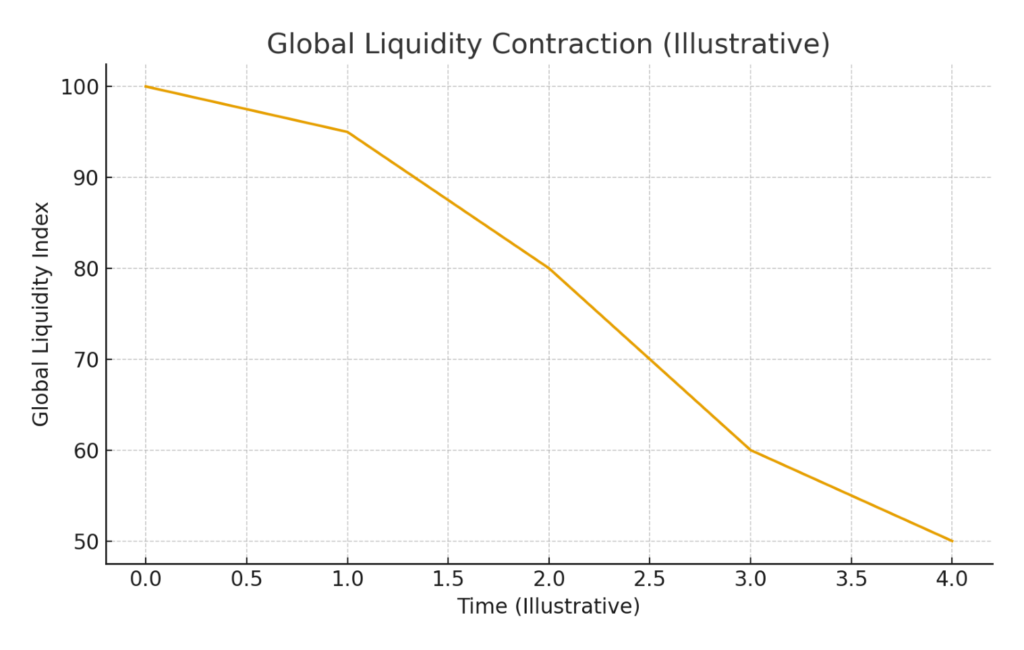
Main Points :
- Global liquidity is tightening due to aggressive monetary policy and geopolitical risks, triggering a broad risk-off environment.
- Bitcoin’s decline below $100,000 is not an isolated crypto correction but a symptom of a deeper macro liquidity shock.
- Investors learned again that Bitcoin has a dual nature: an inflation hedge in one environment but a risk asset during liquidity crises.
- Crypto-related equities crashed in parallel, proving that digital assets are now fully integrated into global financial markets.
- Market participants must shift from short-term sentiment to macro fundamentals, evaluating long-term value and risk tolerance.


1. The Global Liquidity Shock Behind Bitcoin’s Break Below $100,000
Bitcoin’s long-defended psychological line of $100,000 was finally breached, triggering alarm across all risk-asset markets. Contrary to narratives that focus solely on crypto’s internal dynamics, the true cause lies in a global liquidity crisis fueled by unprecedented macroeconomic stress.
Over the past year, major central banks—particularly the Federal Reserve, the Bank of England, and the European Central Bank—have continued tightening liquidity to combat persistent inflation. The result has been a deep squeeze across all markets that rely on leverage, liquidity, or continuous inflows.
Institutional investors, facing both interest-rate pressure and geopolitical uncertainty, rapidly shifted out of volatile assets and into cash-equivalent positions. This created predictable contagion effects:
- Bitcoin sold off sharply.
- Ethereum and other high-beta altcoins followed.
- Crypto-related equities plunged.
- Mining stocks experienced double-digit declines.
- Liquidity on exchanges thinned dramatically.
Institutional portfolios typically reduce exposure in a very specific order during risk-off phases:
- High-volatility assets (crypto)
- Growth equities
- Emerging markets
- Commodities (except oil during wartime)
Crypto sits at the very top of this ladder, making it the first asset class to experience forced selling.
The most critical lesson from this event is that Bitcoin is no longer a niche asset—it is now fully embedded in global financial flows. When liquidity vanishes, Bitcoin drops alongside equities and other risk assets, marking a major milestone in the market’s maturation.
2. Bitcoin’s Dual Nature: Inflation Hedge and Risk Asset Under Pressure
Bitcoin’s decline has highlighted a paradox that investors often underestimate:
Bitcoin behaves as an inflation hedge during monetary expansion, but during contraction it behaves like a high-beta risk asset.
This duality has always existed but becomes clearest during extreme macro events.
Why Bitcoin Sells Off During Liquidity Crises
- Liquidity risk dominates inflation expectations.
- Funds unwind leveraged positions, triggering liquidation cascades.
- Market makers widen spreads, causing additional volatility.
- Investors move into USD cash or short-term Treasury bills.
As a result, Bitcoin’s reputation as a safe haven must be understood contextually:
| Market Condition | Bitcoin Behavior |
|---|---|
| Loose monetary conditions | Performs as an inflation hedge, store of value |
| Tight monetary conditions | Performs as a risk asset, highly sensitive to liquidity |
Investors searching for new sources of return—particularly those exploring emerging crypto assets, DeFi yields, tokenized RWAs, or blockchain-based payment platforms—must account for this reality when structuring their portfolios.
What the recent crash really shows is a need for macro-sensitive crypto investment strategies, where capital rotates based not only on on-chain metrics but also global monetary cycles.
3. Market Maturity and Integration: Crypto-Related Equities Fall Together
The simultaneous crash of crypto equities and Bitcoin was no coincidence—it is evidence of full financial integration.
In earlier years, crypto often moved independently of public equity markets.
Those days are gone.
Today, crypto-related stocks—exchanges, mining companies, blockchain developers—are tightly correlated with Bitcoin’s price, as institutional capital increasingly treats them as a single thematic exposure.
What This Integration Means
- Crypto is now part of global macro portfolios.
- Institutional flows affect Bitcoin just as they affect equities and bonds.
- Corporate valuations of crypto companies depend on Bitcoin’s price.
- Market transparency and regulatory expectations are rising sharply.
This is not inherently negative—deep integration makes institutional adoption easier.
However, it also makes Bitcoin vulnerable to the same macro shocks that affect traditional markets.
The liquidity crisis demonstrated this vividly:
Bitcoin dropped → crypto stocks collapsed → related ETFs saw outflows → mining profitability plunged → leverage decreased → Bitcoin dropped further.
A complete loop.
This reflexivity is now a permanent feature of the industry.
4. Navigating the Uncertainty: What Investors Should Focus On Now
Short-term volatility can be distracting, but the real drivers of Bitcoin’s performance are:
- Global liquidity cycles
- Central bank policy signals
- Long-term supply dynamics (halving impact)
- Institutional inflows and regulatory clarity
- Adoption in payments, remittances, and stablecoin infrastructure
As the market matures, macro literacy becomes essential for crypto investors.
Strategic Considerations for Investors Seeking New Crypto Opportunities
- Evaluate liquidity risk first, not last.
- Diversify into assets with real-world utility, including cross-border payments, tokenized assets, and stablecoin settlement networks.
- Monitor mining difficulty and network health as leading indicators.
- Analyze corporate earnings of crypto-related stocks as part of crypto research.
- Build strategies aligned with monetary policy cycles, not solely crypto-native trends.
The current environment may feel painful, but historically, liquidity crises have often produced the best long-term entry points for new tokens and blockchains with strong fundamentals and real utility.
Conclusion: A New Era of Crypto–Macro Convergence
Bitcoin’s fall below $100,000 is not simply a price event—
it is a macro event, signaling that cryptocurrency is now fully intertwined with the global economy.
The liquidity crisis exposed three undeniable truths:
- Bitcoin is a major global risk asset, no longer isolated.
- Liquidity, not sentiment, drives large-scale moves.
- Investors must adopt macro-informed strategies to identify new opportunities and protect capital.
In this environment, new crypto assets, practical blockchain applications, and high-value token ecosystems will attract investor attention—especially those that solve real financial problems rather than relying solely on speculative demand.
The next phase of the crypto market will belong not to the loudest narratives but to the assets that align with both macro reality and real-world utility.

